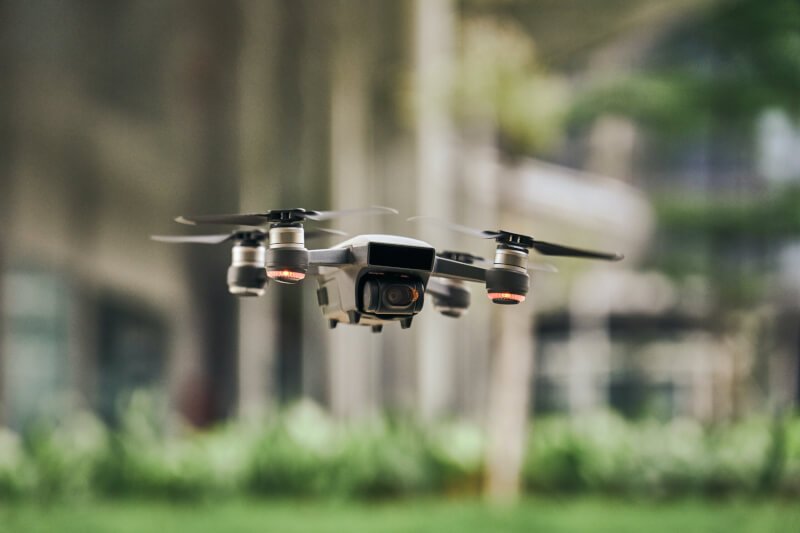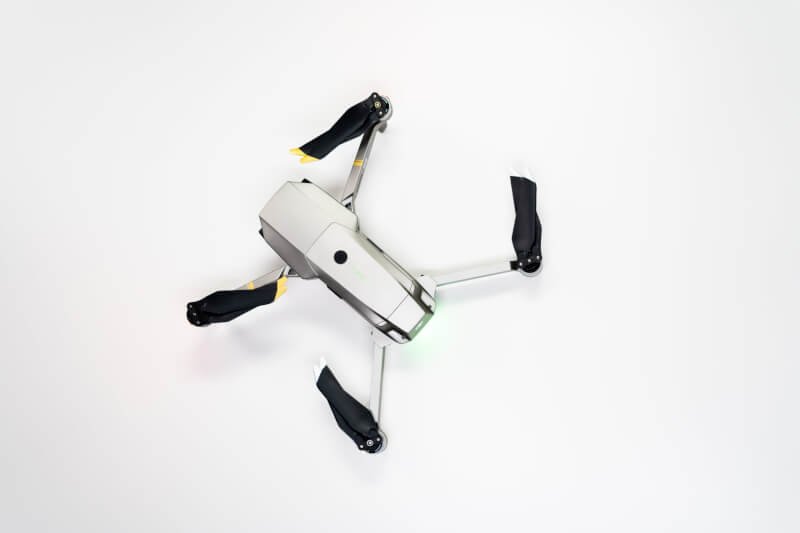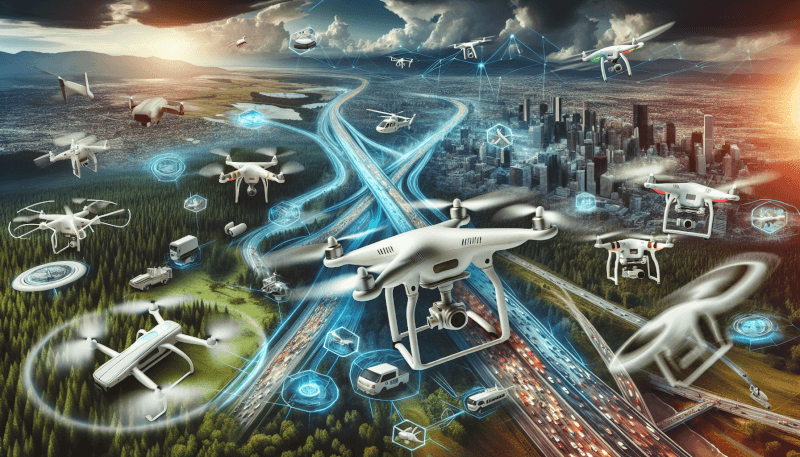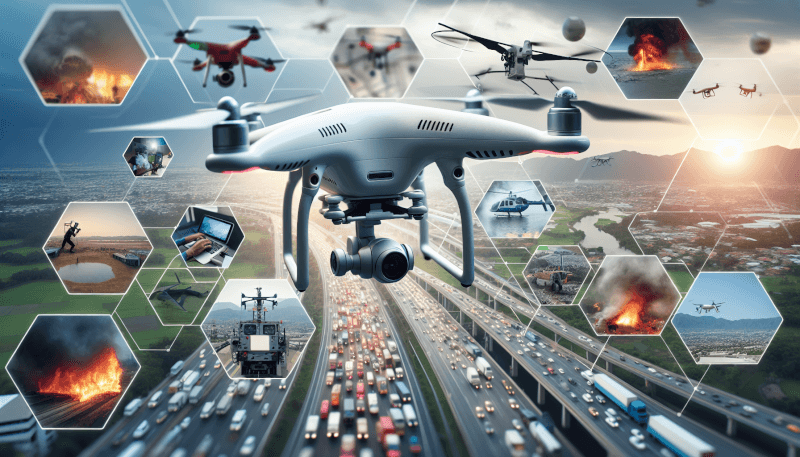In today’s rapidly evolving world, drones are revolutionizing the way public safety and law enforcement agencies carry out their duties. With their impressive range of features and capabilities, these unmanned aerial vehicles are proving to be invaluable tools in various aspects of keeping communities safe. From monitoring crowds during public events to conducting search and rescue missions in remote areas, drones are enabling authorities to respond more efficiently and effectively. Join us as we explore the endless possibilities that drones are offering in the realm of public safety and law enforcement.

Search and Rescue Operations
Drones have become a valuable tool in search and rescue operations, enabling authorities to locate missing persons more efficiently than ever before. With their aerial capabilities, drones can cover large areas in a short amount of time, increasing the chances of finding individuals who are lost or in distress. By equipping drones with advanced imaging technology and thermal cameras, rescuers can identify heat signatures and other signs of human activity, even in challenging terrains or at night. The ability to quickly locate missing persons is crucial in these situations, as it can mean the difference between life and death.
In addition to searching for missing persons, drones also play a vital role in monitoring disaster areas. When natural disasters strike, such as earthquakes, floods, or hurricanes, they often leave behind extensive destruction and inaccessible locations. Drones can effortlessly navigate these perilous environments, providing valuable real-time information to aid in rescue and recovery efforts. They can capture high-resolution images and videos, allowing emergency response teams to assess the extent of the damage and identify areas that require immediate attention. By monitoring disaster areas from above, drones ensure that no details are missed and that resources are deployed effectively.
Crime Scene Investigation
Drones are revolutionizing crime scene investigation by offering a unique aerial perspective that was previously unattainable. Traditional methods of documenting crime scenes involved taking photographs and measurements from the ground, but this limited view often missed crucial evidence. With drones, investigators can capture comprehensive, high-resolution images from various angles, providing a more complete view of the crime scene. This detailed visual information can be instrumental in analyzing and reconstructing crime scenes, aiding in the identification and prosecution of perpetrators.
Moreover, drones equipped with advanced imaging technologies, such as infrared or multispectral cameras, can detect clues that are invisible to the naked eye. They can identify fingerprints, bloodstains, or other trace evidence that may have otherwise gone unnoticed. Additionally, drones can quickly survey large areas of land to search for discarded weapons, stolen goods, or any other evidence related to the crime. The use of drones in crime scene investigation not only expedites the investigation process but also enhances the accuracy and efficiency of forensic analysis.

Traffic Management
With the ever-increasing number of vehicles on the roads, traffic management has become a significant challenge for authorities. Drones can play a crucial role in monitoring traffic patterns, identifying congested areas, and assisting in accident reconstruction. By capturing real-time video footage from above, drones provide traffic management centers with valuable information, allowing them to make informed decisions and implement effective strategies to alleviate congestion and improve traffic flow.
In the case of accidents, drones can quickly fly to the scene and provide a detailed aerial view, offering a unique perspective to investigators. By accurately mapping the accident scene and capturing high-resolution images, drones assist in reconstructing the events leading up to the incident. This information not only helps determine the cause of the accident but also aids in identifying any potential contributing factors, such as road conditions or driver behavior. Ultimately, the use of drones in traffic management enhances safety, reduces response times, and improves overall traffic efficiency.
Surveillance and Monitoring
Drones have proven to be valuable tools for surveillance and monitoring activities, both in public events and law enforcement operations. In public events, large gatherings can pose challenges in ensuring the safety and security of attendees. Drones equipped with cameras and video recording capabilities provide an aerial vantage point, allowing organizers and security personnel to monitor the crowd, detect potential threats, and take immediate action if necessary. The ability to gather real-time information from above provides a comprehensive view of the event and enables timely responses to any security concerns.
Similarly, in law enforcement operations, drones offer a valuable tool for surveillance and evidence gathering. They can monitor high-risk areas, such as crime-prone neighborhoods or areas experiencing civil unrest, without endangering officers on the ground. Drones equipped with zooming capabilities and night vision cameras can provide law enforcement with valuable intelligence and visual evidence, helping them make informed decisions and take appropriate actions. The use of drones in surveillance and monitoring not only enhances public safety but also reduces the risks and costs associated with traditional surveillance methods.

Emergency Response
Drones have become indispensable in emergency response situations, providing real-time situational awareness and assisting in delivering essential supplies and assessing structural damage. During natural disasters, such as earthquakes or hurricanes, roads may become impassable, and traditional methods of delivering supplies and aid can be hindered. Drones can overcome these challenges by swiftly transporting medical supplies, food, or other critically needed items to affected areas. This rapid response can save lives and provide much-needed relief to those in distress.
Moreover, drones equipped with high-resolution cameras and sensors can assess structural damage to buildings or infrastructure, providing vital information to emergency response teams. This data allows responders to prioritize their efforts, focus on the areas most in need of attention, and ensure the safety of both residents and first responders. By providing real-time situational awareness and contributing to efficient emergency response efforts, drones play a significant role in saving lives and aiding in disaster recovery.
Wildlife Conservation and Environmental Protection
Drones have emerged as powerful tools in wildlife conservation and environmental protection efforts. Monitoring protected areas, such as national parks or wildlife reserves, can be challenging due to their vast size and rugged terrains. Drones equipped with high-resolution cameras and thermal imaging technology can fly above these areas, capturing images and videos that provide valuable data on animal populations, habitat conditions, and potential threats.
Furthermore, drones are instrumental in identifying and combating poaching activities. They can patrol protected areas and monitor for any illegal activities, such as hunting or the capture of endangered species. By providing aerial surveillance, drones help authorities detect poachers before they can cause significant harm to wildlife populations. This proactive approach not only protects endangered species but also helps preserve fragile ecosystems for future generations.

Firefighting Support
When it comes to battling wildfires or other large-scale fires, drones provide crucial support to firefighters on the ground. Drones equipped with thermal cameras can detect fire hotspots, even in areas that are difficult to reach or densely covered by smoke. By identifying these hotspots, firefighters can allocate their resources more effectively, prioritize their efforts, and contain the fire before it spreads further.
Additionally, drones equipped with mapping capabilities and real-time data transmission can track the spread of the fire and provide up-to-date information to incident commanders. This information allows for better coordination between firefighting teams and assists in making informed decisions regarding evacuation orders and resource allocation. The use of drones in firefighting not only enhances the safety of firefighters but also improves the efficiency and effectiveness of fire suppression efforts.
Disaster Assessment and Management
Following a disaster, such as an earthquake or hurricane, it is crucial to conduct aerial damage assessments and map the affected areas accurately. Drones play a vital role in this process, as they can quickly and safely fly over the affected areas, capturing high-resolution images and videos. These images provide invaluable information regarding the extent of the damage, infrastructure weaknesses, and potential hazards.
By utilizing drones for aerial damage assessment, disaster management teams can prioritize their response efforts, allocate resources effectively, and coordinate with other agencies involved in the recovery process. The comprehensive view provided by drones enables efficient decision-making and aids in the swift restoration of critical infrastructure and services. Drones significantly streamline the disaster assessment and management process, ensuring a quicker and more targeted response to affected communities.

Crowd Monitoring and Control
Managing large gatherings, such as protests, festivals, or sporting events, can pose significant challenges for authorities. Drones are proving to be invaluable tools in crowd monitoring and control, enhancing safety for both event participants and law enforcement personnel. Equipped with cameras and video recording capabilities, drones can provide a comprehensive aerial view of the crowd, allowing event organizers and security teams to detect any potential threats or crowd behavior issues.
Moreover, drones can assist in detecting prohibited items or activities, such as unauthorized drone flights or the possession of weapons. This early detection, made possible by the aerial perspective provided by drones, enables law enforcement to take prompt action and minimize risks to public safety. The use of drones in crowd monitoring and control ensures a proactive approach to maintaining order during large gatherings and helps mitigate potential security threats.
Drone-related Legal and Ethical Considerations
As the use of drones becomes more prevalent in public safety and law enforcement applications, it is essential to address the legal and ethical considerations associated with their use. Privacy concerns are a significant issue, as drones have the capability to capture images and videos in public and private spaces. Striking a balance between the need for public safety and individual privacy rights is crucial, and proper protocols must be in place to ensure that data collected by drones is handled responsibly and in compliance with applicable laws.
Regulations and licensing are also important considerations. Pilots flying drones for public safety and law enforcement purposes should be properly trained and certified to operate these devices safely. Additionally, regulations regarding where drones can be flown, altitude limits, and airspace restrictions must be followed to prevent any potential conflicts or dangers.
Data security and storage are other crucial aspects to address. Measures must be in place to safeguard the data collected by drones, ensuring that it is protected from unauthorized access or misuse. Proper storage and handling of data are essential to maintain the integrity of the evidence gathered and to protect the privacy of individuals captured in drone footage.
As the use of drones in public safety and law enforcement continues to evolve, it is vital that these legal and ethical considerations are carefully addressed to maximize the benefits of this technology while ensuring the protection of individuals’ rights and privacy.


